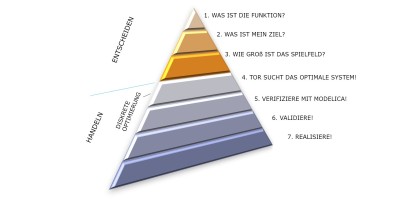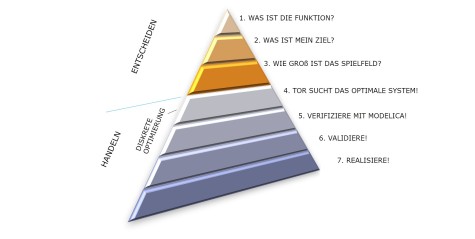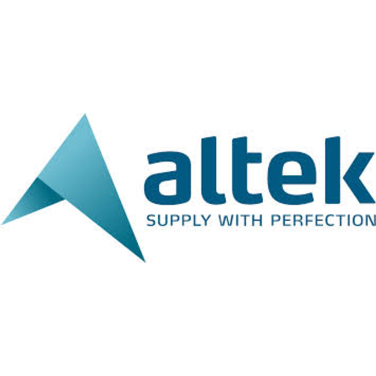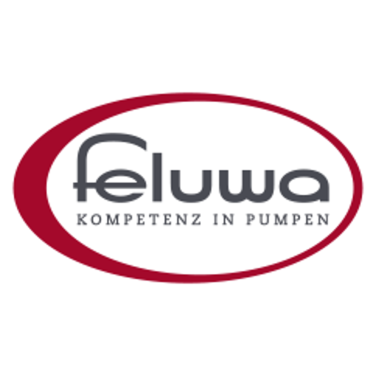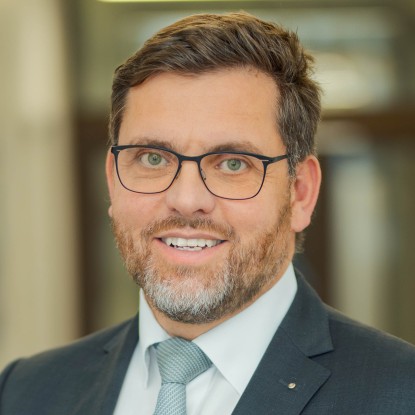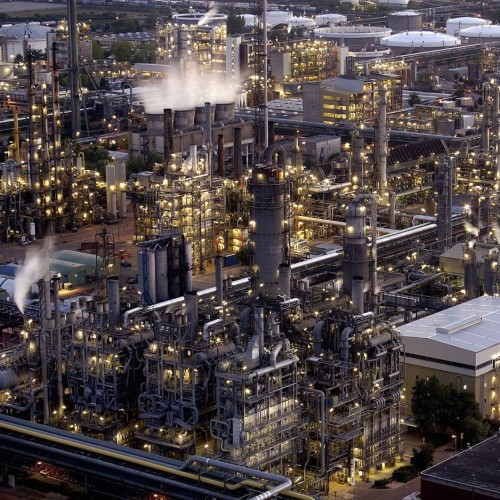
Energy Consumption of Fluid Systems
One fourth of all European power plants are needed for driving pumps, fans or compressors. There is a significant need to enhance these processes in order to get fluid systems that are more sustainable and economic.
In order to reduce energy consumption and the associated CO2 emissions, sustainable system synthesis in the first place and sustainable operation of fluid energy machines and system components in the second place play a major role. In order to optimally design the entire life cycle of a fluid system, it is necessary to keep everything in view, from the components to the overall system. For this reason, our research is based on four key points:
Firstly, innovative product developments must result in more efficient machines and components. In doing so, it is important to consider not only one design point, but the entire operating range.
Secondly, approaches for evaluating the energy efficiency of hydraulic motors, pumps, compressors and fans must be developed and applied in practice. This requires close cooperation with industrial partners and the transfer of efficiency assessments into European legislation and international standardization. The future belongs to the functional units (Extended Product) consisting of fluid energy machine, valve or fitting, motor, frequency converter and sensor technology as well as the digital twin.
Thirdly. Components need to be chosen, connected and operated in order to fulfill their purpose. It is important to focus on correlations during the resulting combinatorial explosion.
We develop, evaluate and validate these in an interdisciplinary way in cooperation between engineering science, mathematics, computer science and the humanities. We establish these methods in the engineering science and make them available for practical application.
Fourthly, in the context of Industry 4.0 and IOT, we aim to leverage further energy saving potentials through intelligent operation and information exchange between fluid technology components at system level.
To solve these tasks, theory and experiment go hand in hand.
Technical Operations Research can help to structure the solution process in order to master the complexity of system design. The goal is to establish mathematical optimisation methods in engineering and to objectify the decision-making process. The questions shown in the figure of the TOR pyramid guide the engineer through the planning process. After defining the function, goal and playing field, the planning problem is transformed into a mathematical optimisation problem. With the help of discrete optimisation, we determine the best possible selection of components, their interconnection and the corresponding control strategy. This system design is then verified using suitable software solutions such as Modelica. In order to validate the calculations and models, we carry out experimental investigations at the institute.
With suitable software solutions we want to contribute to the use of discrete processes in the early design stage of technical systems. We have also published this methodology under the maxim “As good as possible”. Furthermore, we offer the lecture Technical Operations Research (TOR).
For the design of technical systems, we use algorithmic optimisation methods to optimise topology, resilience or operation. For this purpose, we use a variety of methods from the field of operations research and machine learning.
In particular, we use mixed-integer optimisation methods and common software solutions, such as SCIP.
In addition, we develop our own heuristics for finding global or local solutions, which are particularly characterized by a faster solution speed compared to conventional implementations.
For system synthesis, we also use machine learning methods such as clustering or Monte Carlo approaches to derive load profiles and requirements for system design from real-world boundary conditions.
The social developments of modern times require a rethink in the development of technical products and systems. In addition to energy efficiency, modern technical solutions must be characterized by a low environmental impact while at the same time maintaining economic profitability. These requirements are partly in conflict with each other, consequently the optimal technical solution can only be a trade-off between these tension criteria. With the method of multi-pole system analysis, the Chair of Fluid Systems provides an innovative methodological approach for optimal system identification in the tension triangle of sustainability conditions. The multi-pole system analysis (MPSA) method consists of the four steps (i) system synthesis, (ii) system analysis under uncertainty, (iii) stochastic optimization, and final (iv) sensitivity analysis. The method was presented on a conceptual wind energy converter as part of the research project.
Various test rigs are available for the experimental validation of the investigated methods. These test rigs exist on a large and model scale and serve for demonstration, calibration and validation of the components and systems. All relevant process variables can be recorded by means of extensive measurement technology.
Examples from our field of application are:
- modular demonstrator for pump systems
- EuP test bench for pump units
- measurement of the efficiency of positive displacement pumps in the hydraulic pump test field according to ISO 4409
- measurement of fan efficiency according to ISO 5801 and ISO 13348
- measurement of the efficiency of fans by varying the Mach and Reynolds numbers in a specially developed pressure chamber
Softsensors determine a target variable based on the measured variables of existing sensors. They are applied if the environmental conditions prevent real sensors from being used for the target variable or their use would be too expensive. In this way, further information is obtained from the data of existing sensors and thus additional knowledge is generated.
The redundant acquisition of the same process variables within a softsensor network can be used specifically to induce and analyse data conflicts. These data-induced conflicts, which result, among other things, from wear and tear of individual components, are the basis to derive models for the detection of wear and tear.
One of the core competences of the Chair of Fluid Systems is the analytical modeling of physical processes. The created models represent a physical process which can be solved by an equation with analytical solution. The problem is simplified to such an extent that only physical quantities that influence the process are considered (“as little as possible – as much as necessary”).
Furthermore, we use dimensional analysis. With dimensional analysis, a problem can be described in a dimensionless way by relating all quantities to corresponding characteristic quantities of the problem. The resulting dimensionless values help to achieve a compact “generally valid” representation of the results.
The dimensionless results are not only valid for a certain case, but for all physically similar problems. We use this for scaling. The functional data obtained on a model (e.g. reduced image, or model with different material) are transferred to the function of the real fullscale system.
The development of technical products is carried out in an increasingly complex environment with rapidly changing requirements. To meet these challenges, approaches from agile software development can be transferred to the development of physical products. Thus, important insights can be generated in early stages of product development by building prototypes. By using hardware-in-the-loop, components can be realistically examined with reduced experimental effort.
Our institute's own workshop enables us to build prototypes quickly and efficiently. This plays an essential role in the setup and maintenance of our test rigs and experiments.
Our developments are always based on existing problems and matching solutions. We pursue the goal of maximizing the customer's benefit.
Currently we are developing an innovative control valve in the focus of “Sustainable System Design”.
In the design process of pump systems, not only the optimum number, size and operating points of pumps must be determined, but also the optimum arrangement of the pumps to each other (serial or parallel pump operation).
Together with VDMA Pumpen + Systeme, IoT concepts for positive displacement pumps are being investigated in preparation for an AiF project. The aim is to implement such a concept as a demonstrator on an existing pump test bench, considering the developing standards in the context of Industry 4.0. Among other things, existing research results on the topic of soft sensors will be used to show how a practical implementation can be realized and used in industrial applications. Therefore, special attention is paid to knowledge transfer to the industrial partners.
Within the prototypical implementation, the machine-to-machine communication is carried out via the OPC UA standard defined in IEC 62541 under consideration of the OPC UA Companion Specifications for pumps and vacuum pumps. Thus, a platform- and manufacturer-independent information exchange can be guaranteed.
The project is an industrial joint research venture (AiF project) in cooperation with pump manufacturers and BASF AG. This ensures practical relevance and technology transfer.
The WIPANO project “model-based efficiency prediction” focuses on efficiency scaling for fans starting from a physically based model. The project aims at a draft ISO standard for up- and downscaling fan efficiency of axial, mixed flow and centrifugal design. The development of the scaling method shall be applied on the national (DIN/DKE), European (CEN/CENELEC) and international (ISO/IEC) level as standard ISO 13348.
Experimental investigations will be carried out at the Institute of Fluid Systems. They include the characteristic curve measurements of scaled centrifugal fans without housing as well as mixed flow fans, which are exposed to a Reynolds and Mach number variation in a pressure chamber.
Characteristic curve data are provided by industrial partners to evaluate the method to its functionality. The valuable industry data is used for validation, making the method reliable.
Control valves are important components in all process engineering plants. Together with pumps, they are the main actuators for controlling and regulating the production process. At the Chair of Fluid Systems we are working on the development of a new type of throttle valve. By clever separation and integration of functions we reduce the complexity for the user. The new valve type allows a much more compact design and thus saves materials. In addition to product development, we are also researching ways to save energy. The flow-optimized design of the valve achieves low pressure loss coefficients in open position. These possible low pressure losses must be considered in the overall context of the system in order to identify potential savings.
The focus of SFB 805 is the resilience of technical systems. A resilient system maintains a minimum functionality in case of failure, such as a component failure, and can recover from the failure. The resilience of technical systems and infrastructures can be measured, evaluated and optimized by means of graph-theoretical metrics. This method is based on network theory, whereby the basic system is represented as a mathematical graph. As application examples for the methods used, research has already been carried out on the resilient topology determination for water supply systems in high-rise buildings.
In addition, in SFB805 we research on the design of resilient dynamic systems, which ideally react autonomously to disturbances by topology or control adjustments.
In the context of urbanization, the optimal adaptation of existing infrastructure structures to future needs is an important aspect. In this research project, the water infrastructure is optimized with regard to its resilience with the help of the presented methods above.
| Topic | |
|---|---|
| Robust validation and extension of an upscaling methodology for centrifugal fans | |
| ERP Positive Displacement Pumps – Physically Based Approach Towards an Application Related Efficiency Guideline | Publication |
| Efficiency upscaling for fans | Dissertation |
| The dynamic operating behaviour of screw pumps | Dissertation |
| Development and validation of a new process for efficiency upscaling of axial fans in the entire operating range | Dissertation |
| Correlation between geometry, operating behaviour and acoustics in axial turbomachinery | Dissertation |
| Virtual exhaust-gas turbocharger | Dissertation |
| Development of the Energy Efficiency Index (EEI) for centrifugal pumps and booster pumps |
Publication Publication |
| Highly efficient pump systems | BMWi-cooperative project “HEP” |
|
Optimisation of Process Chains under Uncertainty |
Collaborative Research Centre 805, subproject B1 |
| Mathematical optimisation of water supply networks for informal settlements in mega cities | Dissertation |
| Development of a holistic methodological approach for optimal system identification in the conflict triangle of sustainability conditions | Dissertation |
| Experimental validation of a type-independent efficiency model for positive displacement pumps | Report (opens in new tab) |
| On the influence of the free surface on the power yield of hydropower at low heads | Dissertation |
| Global optimisation of pumping systems | Report (opens in new tab) |
| HECTOR | Report |

Error on loading data
An error has occured when loading publications data from TUbiblio. Please try again later.
-
{{ year }}
-
; {{ creator.name.family }}, {{ creator.name.given }}{{ publication.title }}.
; {{ editor.name.family }}, {{ editor.name.given }} (eds.); ; {{ creator }} (Corporate Creator) ({{ publication.date.toString().substring(0,4) }}):
In: {{ publication.series }}, {{ publication.volume }}, In: {{ publication.book_title }}, In: {{ publication.publication }}, {{ publication.journal_volume}} ({{ publication.number }}), ppp. {{ publication.pagerange }}, {{ publication.place_of_pub }}, {{ publication.publisher }}, {{ publication.institution }}, {{ publication.event_title }}, {{ publication.event_location }}, {{ publication.event_dates }}, ISSN {{ publication.issn }}, e-ISSN {{ publication.eissn }}, ISBN {{ publication.isbn }}, DOI: {{ publication.doi.toString().replace('http://','').replace('https://','').replace('dx.doi.org/','').replace('doi.org/','').replace('doi.org','').replace("DOI: ", "").replace("doi:", "") }}, Official URL, {{ labels[publication.type]?labels[publication.type]:publication.type }}, {{ labels[publication.pub_sequence] }}, {{ labels[publication.doc_status] }} - […]
-
Number of items in this list: >{{ publicationsList.length }}
Only the {{publicationsList.length}} latest publications are displayed here.


